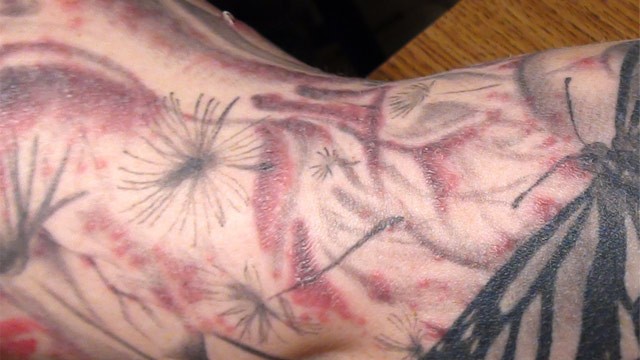ABC - A Trail of Ink: Tracking a Rare Tattoo-Related Infection
A Trail of Ink: Tracking a Rare Tattoo-Related Infection

The reddish-purple rash, seemingly woven into the tattoo on a 20-year-old New Yorker's forearm, was strange enough to have doctors scratching their heads.
This trail began when the man received a tattoo in Rochester, N.Y. in October 2011. A short while later, he noticed the raised, bumpy rash. He called his primary care physician.
Doctors initially treated the man's arm with topical steroids, thinking that the rash was allergic-contact dermatitis. But that only made the problem worse.
By the time dermatologist Dr. Mark Goldgeier saw the patient, it was clear that this was no simple allergy.
He performed a skin biopsy so he could take a closer look at the rash under a microscope. What he saw was startling: the sample was riddled with a wormlike bacterium related to tuberculosis.
"I explained [to the patient] that he had TB, and he had a look of horror on his face," Goldgeier said.
For the patient, the finding meant a trip to an infectious disease specialist to start up to a full year of treatment.
Goldgeier, meanwhile, called the Monroe County Health Department.
"As soon as biopsy came back," he said, "I knew something in the process of tattooing was involved -- the ink, the water used for dilution, the syringes, the dressings."
And so began a nationwide medical mystery.
Dr. Byron Kennedy, public health specialist at Monroe County Department of Public Health, took over the case from Goldgeier. Kennedy first confirmed the results by repeating a skin biopsy on the patient. Once again, tendrils of mycobacterium chelonae, a type of tuberculosis-related skin bacteria, showed up in the sample.
Mycobacterium chelonae is a rapidly growing bug found in soil, dust, water, animals, hospitals, and contaminated pharmaceuticals. This family of bacteria does not commonly affect healthy individuals, but in patients with suppressed immune systems -- like those with HIV or on chemotherapy -- these bacteria can cause serious disease, often resulting in death.
The finding sent Kennedy and his associates to the tattoo parlor where the patient had been inked. Everything in the clinic was sterile, which made it unlikely that the infection had arisen there. But the tattoo artist, they learned, had been using a new gray premixed ink purchased in Arizona in April 2011; he used the ink between May and December 2011.
The ingredients of the ink -- pigment, witch hazel, glycerin, and distilled water -- seemed innocuous enough. But further examination revealed that the distilled water in the pigment was the likely culprit of the contamination.
The finding raised a number of questions -- not the least of which was how the bottles of premixed ink passed U.S. Food and Drug Administration regulations.
The U.S. Centers for Disease Control and Prevention acknowledged this gap in regulations Wednesday in its Morbidity and Mortality Weekly report.
"Under the Federal Food, Drug, and Cosmetic Act, tattoo inks are considered to be cosmetics, and the pigments used in the inks are color additives requiring premarket approval," the report says.
While the pigments are subject to FDA monitoring, "no specific FDA regulatory requirement explicitly provides that tattoo inks must be sterile," they said.
Local jurisdictions can further regulate the practice of tattooing, with Los Angeles County cited by the CDC as an area where only sterile water is allowed for use with tattoo ink. This is not, however, uniform around the country.
In a perspective article published Wednesday in the New England Journal, Pamela LeBlanc of the FDA comments on this.
"Even if a person receives a tattoo at a tattoo parlor that maintains the highest standards of hygienic practice, there remains a risk of infection from the use of contaminated ink," she writes.
Kennedy had found the source of infection in this patient's case. Now, he and his colleagues focused on both treatment as well as source control.
"To make sure we weren't missing any cases, we contacted all 60 tattoo parlors in the county," Kennedy said. Luckily, none of the other parlors had been in contact with the contaminated ink. Kennedy then instructed nearby pathology labs to notify the county health department of any reported cases of this same infection. Due to these combined efforts, 19 cases of this atypical and difficult-to-treat skin infection were identified and treated, all from the same tattoo parlor. Kennedy and his team then turned the case over to the FDA.
"This case really put it on the radar of the FDA," Kennedy said.
And it was not a day too soon. CDC testing revealed that 1 out of 3 unopened bottles of the gray ink from the original distributor in Arizona contained mycobacterium chelonae. The CDC then issued a national alert for local health officials to be on the lookout for tattoo-related infections caused by this bacteria.
According to the CDC, 21 percent of adults in the U.S. report having at least one tattoo -- an increase from 14 percent in 2008. But with this burden of ink comes increased need for monitoring of safe practices and tattoo-related complications -- especially skin infections.
The CDC urges consumers to be vigilant about ensuring hygienic practices at their tattoo parlor of choice, and to alert health care providers at any sign of infection or rash.
Doctors, meanwhile, are urged to report suspected or confirmed cases to FDA's MedWatch program.
"The local dermatologist was the person to put this on our radar," said John Ricci, Senior Public Health Educator at the Monroe County Department of Health. "Without this initial case report to us, it would never have been detected."